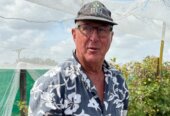
Rob Hocking leading the Cambridge Brass Band during the museum project launch.
A Bastille Day gathering at Cambridge’s St Andrew’s Church launched an awareness and fundraising campaign aimed at establishing a permanent New Zealand Memorial Museum in our French sister city, Le Quesnoy.
The gathering launched the New Zealand Memorial Museum Trust’s project to purchase and develop a museum in the town as a permanent record for future generations.
The choice of Le Quesnoy as its site acknowledges not only the sacrifice of those involved in liberating the town in 1918, but also marks the forging of New Zealand’s broader military heritage and national identity.
New Zealand infantry troops liberated Le Quesnoy from German occupation on November 4, 1918, when soldiers used a ladder to climb the town walls. The ensuing battle resulted in 122 New Zealand deaths, with many of those having survived Gallipoli, the Somme and Passchendaele only to be lost within a week of the November 11 Armistice.
Herb Farrant, founder and secretary general of the New Zealand War Memorial Museum Trust, said that bringing the museum project to fruition marked years of hard work. He said New Zealand’s international military reputation had not been established by the 1914 onset of World War 1, but Kiwi participation during both world wars led to a unique national identity being forged and universal recognition given to the commitment of New Zealand soldiers – one made more extraordinary because of the country’s small population at the time.

Pictured after the launch are, from left, NZ War Memorial Museum Trust founder Herb Farrant; Cambridge Community Board chairman Mike Pettit; Colin Averill, son of the man who in 1918 was first to scale the wall surrounding Le Quesnoy; and Waipa District Mayor Jim Mylchreest.
He described WW1 as “the great juggernaut of history which changed forever those drawn into the conflict half a world away”. New Zealand became heavily involved, and the museum project presented an opportunity to “permanently record, remember and honour the memory of our country’s fittest and finest” who fought in both world wars.
The time to do that was now, as the 1918 centenary marking the end of WW1 approaches and with it a risk that its lessons might be increasingly forgotten.
“History’s teachings show that everything we value and treasure will at some time need to be defended against aggression. We know this today when we face the situation of global terrorism.”
The $15 million museum project seeks to purchase and develop a 19th century property in Le Quesnoy. Once the residence of the town’s mayor, it became the local gendarmerie in 1952. Plans are to develop former staff housing surrounding the historic homestead into visitor accommodation, and build a modern new annex as exhibition space. Together the old residence and annex will form the museum that will tell Kiwi soldiers’ stories, and exhibit collections from both world wars.

The historic property in Le Quesnoy that is earmarked for development into a New Zealand Memorial Museum.
It is hoped fundraising efforts will enable the property to be purchased, and for the first stage to be developed by November 4, 1918 – in time to commemorate the 100th anniversary of the liberation of Le Quesnoy.
Waipa District Mayor Jim Mylchreest congratulated the Trust for promoting the project and said it had particular relevance to Cambridge as its sister-city connection with Le Quesnoy had engendered a close friendship between the two towns. “Cambridge will work with the Trust and with central government to ensure this project is successfully completed.”
Cambridge Community Board chairman Mike Pettit described it as a “significant project of historical current and future importance to all New Zealanders and the people of Le Quesnoy”.
NZ War Memorial Trust chairman Greg Moyle said half of all New Zealanders who died on active service during the 20th century were buried in the fields of Europe, and said the events leading to those deaths were in danger of becoming forgotten.
Also attending the launch was Colin Averill, whose father was the first Kiwi soldier to get to the top of the ladder and over the ramparts at Le Quesnoy.
Mr Averill suggested his father, who died in 1981, would likely be overwhelmed at how much attention this one action had generated over the years. He had been a 19-year-old medical intern in Auckland when he and a friend had joined up – his friend was never to return from battle.
“It is likely that my father was just an impulsive 21-year-old keen to get on the ladder first.”
Those present watched a video message of support from Le Quesnoy Mayor, Marie-Sophie Lesne, and listened to readings by Cambridge High and St Peter’s school students. They also heard first-hand accounts of visits to Le Quesnoy from Sarah Ulmer and Madeline Wilson, and were accompanied by music from the Cambridge Brass Band.








